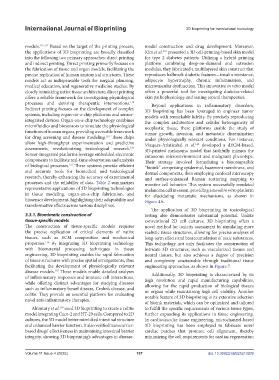Page 115 - v11i4
P. 115
International Journal of Bioprinting 3D bioprinting for translational toxicology
models. 116,117 Based on the target of the printing process, model construction and drug development. Moreover,
the applications of 3D bioprinting are broadly classified Kim et al. presented a 3D cell-printing-based skin model
139
into the following two primary approaches: direct printing for type 2 diabetes patients. Utilizing a hybrid printing
and indirect printing. Direct printing primarily focuses on platform combining drop-on-demand and extrusion
the fabrication of tissue and organ models, facilitating the modules, they fabricated a multilayered skin construct that
precise replication of human anatomical structures. These reproduces hallmark diabetic features—insulin resistance,
models act as indispensable tools for surgical planning, adipocyte hypertrophy, chronic inflammation, and
medical education, and regenerative medicine studies. By microvascular dysfunction. This innovative in vitro model
closely mimicking native tissue architecture, direct printing offers a powerful tool for investigating diabetes-related
offers a reliable framework for investigating physiological skin pathophysiology and testing topical therapeutics.
processes and devising therapeutic interventions. Beyond applications in inflammatory disorders,
118
Indirect printing focuses on the development of complex 3D bioprinting has been leveraged to engineer tumor
systems, including organ-on-a-chip platforms and sensor- models with remarkable fidelity. By precisely reproducing
integrated devices. Organ-on-a-chip technology combines the complex architecture and cellular heterogeneity of
microfluidics and biosensors to simulate the physiological neoplastic tissue, these platforms enable the study of
functions of human organs, providing a versatile framework tumor growth, invasion, and metastatic dissemination
for drug screening and disease modeling. These chips under physiologically relevant conditions. For instance,
119
allow high-throughput experimentation and predictive Vázquez‐Aristizabal et al. developed a dECM-based,
140
assessments, revolutionizing toxicological research. 3D-printed melanoma model that faithfully mimics the
120
Sensor-integrated platforms leverage embedded electronic cutaneous microenvironment and malignant phenotype.
components to facilitate real-time observation and analysis Their strategy involved formulating a biocompatible
of biological processes. These systems provide efficient “bioink” comprising epidermal, basement membrane, and
121
and accurate tools for biomedical and toxicological dermal components, then employing confocal microscopy
research, thereby enhancing the accuracy of experimental and surface‐enhanced Raman scattering mapping to
processes and the reliability of data. Table 2 summarizes monitor cell behavior. This system successfully emulated
representative applications of 3D bioprinting technologies melanoma cell invasion, providing a novel in vitro platform
in tissue modeling, organ-on-a-chip fabrication, and for elucidating metastatic mechanisms, as shown in
biosensor development, highlighting their adaptability and Figure 4A.
transformative effects across various disciplines.
The application of 3D bioprinting in toxicological
3.3.1. Biomimetic construction of testing also demonstrates substantial potential. Unlike
tissue-specific models conventional 2D cell cultures, 3D bioprinting offers a
The construction of tissue-specific models requires novel method for toxicity assessment by simulating more
the precise replication of critical elements of native realistic tissue structures, allowing for precise analyses of
tissues, such as ECM composition and mechanical long-term effects and bioaccumulation of toxic substances.
properties. By integrating 3D bioprinting technology This technology not only facilitates the construction of
136
with biomaterial processing techniques in tissue intricate 3D structures, such as vascularized tissues and
engineering, 3D bioprinting enables the rapid fabrication neural tissues, but also achieves a degree of precision
of tissue structures with precise spatial arrangements, thus and complexity unattainable through traditional tissue
facilitating the development of physiologically relevant engineering approaches, as shown in Figure 7.
137
disease models. These models enable detailed analyses
Additionally, 3D bioprinting is characterized by its
of inflammatory responses and immune cell interactions, high resolution and rapid manufacturing capabilities,
while offering distinct advantages for studying diseases allowing for the rapid production of biological tissues
such as inflammatory bowel disease, Crohn’s disease, and or organs while maintaining high cell viability. Another
colitis. They provide an essential platform for evaluating notable feature of 3D bioprinting is its extensive selection
novel anti-inflammatory therapies.
of bioink materials, which can be optimized and tailored
Almutary et al. used 3D bioprinting to create a colitis to fulfill the specific requirements of various tissue types,
138
model integrating Caco-2 and HT-29 cells. Compared to 2D further expanding its applications in tissue engineering.
cultures, the 3D model better mimicked intestinal structure In cardiovascular tissue engineering, microchannel-based
and enhanced barrier function. It also verified nanocarrier- 3D bioprinting has been employed to fabricate novel
based drugs’ effectiveness in maintaining intestinal barrier cardiac patches that promote cell alignment, thereby
integrity, showing 3D bioprinting’s advantages in disease- minimizing the cell requirements for cardiac regeneration
Volume 11 Issue 4 (2025) 107 doi: 10.36922/IJB025210209

